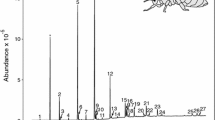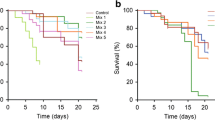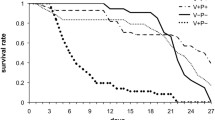Abstract
Pollen feeding in the honeybee (Apis mellifera) is dependent on the caste, ethotype, and dominance status of individuals. Pollen is the near-exclusive external source of lipids for the colony. Lipids from pollen are rich in polyunsaturated fatty acyl residues, which, because of their sensitivity to lipid peroxidation, have been suggested to limit the lifespan of individual bees. We here investigated whether the spectrum of phosphatidylcholine (PC), the main class of membrane-constituting lipids in insects, is indeed, connected to pollen feeding. We further studied the relationship between pollen feeding, PC spectra, and fat-body stores of vitellogenin, an indicator of potential longevity in bees. For this, we determined the pollen consumption, PC spectra, abdominal vitellogenin stores, and behavioral as well as reproductive status of individuals in queenless groups of workers. In contrast to earlier studies, we found that reproduction in workers is not universally linked to trophallactic dominance alone, but can be accompanied by strong pollen consumption. Pollen consumption seemed connected to a strong remodeling of tissue PC spectra. There was no systematic link between these spectra and trophallactic activity, but individuals with strongly deviating spectra also showed extreme behavioral profiles. Abdominal vitellogenin was strongly and positively linked to pollen-influenced PC spectra and the prevalence of polyunsaturated fatty acyl residues, contradicting the hypothesis that pollen consumption is systematically leading to a shorter lifespan in workers. Our results suggest that the association between pollen consumption, short lifespan, and functional sterility that differentiates workers from queens cannot in all cases be extended to the situation within the worker caste.





Similar content being viewed by others
References
Abbott SK, Else PL, Atkins TA, Hulbert AJ (2012) Fatty acid composition of membrane bilayers: Importance of diet polyunsaturated fat balance. Biochim Biophys Acta Biomembr 1818:1309–1317. https://doi.org/10.1016/j.bbamem.2012.01.011
Amdam GV et al (2004) Hormonal control of the yolk precursor vitellogenin regulates immune function and longevity in honeybees. Exp Gerontol 39:767–773
Amdam GV (2011) Social context, stress, and plasticity of aging. Aging Cell 10:18–27. https://doi.org/10.1111/j.1474-9726.2010.00647.x
Amdam GV, Aase ALTO., Seehuus SC, Fondrk MK, Norberg K, Hartfelder K (2005a) Social reversal of immunosenescence in honey bee workers. Exp Gerontol 40:939–947
Amdam GV, Norberg K, Omholt SW, Kryger P, Lourenco AP, Bitondi MMG, Simoes ZLP (2005b) Higher vitellogenin concentrations in honey bee workers may be an adaptation to life in temperate climates. Insectes Soc 52:316–319
Arien Y, Dag A, Zarchin S, Masci T, Shafir S (2015) Omega-3 deficiency impairs honey bee learning. Proc Natl Acad Sci USA 112:15761–15766. https://doi.org/10.1073/pnas.1517375112
Basile R, Pirk CWW, Tautz J (2008) Trophallactic activities in the honeybee brood nest—heaters get supplied with high performance fuel. Zoology 111:433–441. https://doi.org/10.1016/j.zool.2007.11.002
Beenakkers AMT (1969) Carbohydrate and fat as a fuel for insect flight. A comparative study. J Insect Physiol 15:353–361. https://doi.org/10.1016/0022-1910(69)90281-9
Bitondi MM, Simoes ZLP (1996) The relationship between level of pollen in the diet, vitellogenin and juvenile hormone titres in Africanized Apis mellifera workers. J Apic Res 35:27–36
Bligh EG, Dyer WJ (1959) A rapid method of total lipid extraction and purification. Can J Biochem Physiol 37:911–917. https://doi.org/10.1139/o59-099
Canavoso LE, Jouni ZE, Karnas KJ, Pennington JE, Wells MA (2001) Fat metabolism in insects. Annu Rev Nutr 21:23–46. https://doi.org/10.1146/annurev.nutr.21.1.23
Chintalapati S, Kiran MD, Shivaji S (2004) Role of membrane lipid fatty acids in cold adaptation. Cell Mol Biol (Noisy-le-Grand) 50:631–642
Colinet H, Renault D, Javal M, Berkova P, Simek P, Kostal V (2016) Uncovering the benefits of fluctuating thermal regimes on cold tolerance of drosophila flies by combined metabolomic and lipidomic approach. Biochim Et Biophys Acta Mol Cell Biol Lipids 1861:1736–1745. https://doi.org/10.1016/j.bbalip.2016.08.008
Crailsheim K, Hrassnigg N, Gmeinbauer R, Szolderits MJ, Schneider LHW, Brosch U (1993) Pollen utilization in non-breeding honeybees in winter. J Insect Physiol 39:369–373. https://doi.org/10.1016/0022-1910(93)90024-L
Dade HA (1962) Anatomy and dissection of the honeybee. International Bee Research Association, London
Fuchs B, Schober C, Richter G, Süss R, Schiller J (2007) MALDI-TOF MS of phosphatidylethanolamines: different adducts cause different post source decay (PSD) fragment ion spectra. J Biochem Biophys Methods 70:689–692. https://doi.org/10.1016/j.jbbm.2007.03.001
Graham J, Ambrose J, Langstroth L (1992) The hive and the honey bee. Revised Edition. Dadant & Sons, Hamilton
Guidugli KR, Nascimento AM, Amdam GV, Barchuk AR, Omholt SV, Simoes ZLP, Hartfelder K (2005) Vitellogenin regulates hormonal dynamics in the worker caste of a eusocial insect. FEBS Lett 579:4961–4965
Guschina IA, Harwood JL (2006) Mechanisms of temperature adaptation in poikilotherms. FEBS Lett 580:5477–5483. https://doi.org/10.1016/j.febslet.2006.06.066
Haddad LS, Kelbert L, Hulbert AJ (2007) Extended longevity of queen honey bees compared to workers is associated with peroxidation-resistant membranes. Exp Gerontol 42:601–609. https://doi.org/10.1016/j.exger.2007.02.008
Havukainen H, Münch D, Baumann A, Zhong S, Halskau Ø, Krogsgaard M, Amdam GV (2013) Vitellogenin recognizes cell damage through membrane binding and shields living cells from reactive oxygen species. J Biol Chem 288:28369–28381. https://doi.org/10.1074/jbc.M113.465021
Haydak MH (1970) Honeybee nutrition. Annu Rev Entomol 15:143–156
Hepburn HR, Bernard RT, Davidson BC, Muller WJ, Lloyd P, Kurstjens SP, Vincent SL (1991) Synthesis and secretion of beeswax in honeybees. Apidologie 22:21–36
Hodkova N, Simek P, Zahradnickova H, Novakova O (1999) Seasonal changes in the phospholipid composition in thoracic muscles of a heteropteran, Pyrrhocoris apterus. Insect Biochem Mol Biol 29:367–376
Hsieh Y-S, Hsu C-Y (2011a) The changes of age-related molecules in the trophocytes and fat cells of queen honeybees (Apis mellifera). Apidologie 42:728–739. https://doi.org/10.1007/s13592-011-0085-x
Hsieh Y-S, Hsu C-Y (2011b) Honeybee trophocytes and fat cells as target cells for cellular senescence studies. Exp Gerontol 46:233–240. https://doi.org/10.1016/j.exger.2010.10.007
Hulbert AJ, Abbott SK (2012) Nutritional ecology of essential fatty acids: an evolutionary perspective. Aust J Zool 59:369–379. https://doi.org/10.1071/ZO11064
Hulbert AJ, Pamplona R, Buffenstein R, Buttemer WA (2007) Life and death: metabolic rate, membrane composition, and life span of animals. Physiol Rev 87:1175–1213. https://doi.org/10.1152/physrev.00047.2006
IBM (2011) IBM SPSS statistics 20 core system user’s guide. IBM Corporation, Armonk
Kent CF, Issa A, Bunting AC, Zayed A (2011) Adaptive evolution of a key gene affecting queen and worker traits in the honey bee, Apis mellifera. Mol Ecol 20:5226–5235. https://doi.org/10.1111/j.1365-294X.2011.05299.x
Komosinska-Vassev K, Olczyk P, Kaźmierczak J, Mencner L, Olczyk K (2015) Bee pollen: chemical composition and therapeutic application. Evid Based Complement Alternat Med 2015:297425 https://doi.org/10.1155/2015/297425
Koštál VR, Berková P, Šimek P (2003) Remodelling of membrane phospholipids during transition to diapause and cold-acclimation in the larvae of Chymomyza costata (Drosophilidae). Comp Biochem Physiol B Biochem Mol Biol 135:407–419. https://doi.org/10.1016/S1096-4959(03)00117-9
Lercker G, Capella P, Conte LS, Ruini F, Giordani G (1981) Components of royal jelly: I. Identification of the organic acids. Lipids 16:912–919. https://doi.org/10.1007/BF02534997
Lercker G, Capella P, Conte LS, Ruini F, Giordani G (1982) Components of Royal Jelly II. The lipid fraction, hydrocarbons and sterols. J Apic Res 21:178–184. https://doi.org/10.1080/00218839.1982.11100538
Los DA, Murata N (2004) Membrane fluidity and its roles in the perception of environmental signals. Biochim et Biophys Acta 1666:142–157. https://doi.org/10.1016/j.bbamem.2004.08.002
Maurizio A (1954) Pollenernährung und Lebensvorgänge bei der Honigbiene (Apis mellifica L.). Landwirtschaftliches Jahrbuch der Schweiz 68:115–182
Maurizio A (1961) Lebensdauer und Altern bei der Honigbiene (Apis mellifica L.). Gerontologia 5:110–128
Nelson CM, Ihle KE, Fondrk MK, Page RE, Amdam GV (2007) The gene vitellogenin has multiple coordinating effects on social organization. PLoS Biol 5:673–677
Nimse SB, Pal D (2015) Free radicals, natural antioxidants, and their reaction mechanisms. RSC Adv 5:27986–28006. https://doi.org/10.1039/C4RA13315C
Page RE Jr, Peng CYS (2001) Aging and development in social insects with emphasis on the honey bee, Apis mellifera L. Exp Gerontol 36:695–711. https://doi.org/10.1016/S0531-5565(00)00236-9
Pamplona R (2008) Membrane phospholipids, lipoxidative damage and molecular integrity: A causal role in aging and longevity. Biochim et Biophys Acta 1777:1249–1262. https://doi.org/10.1016/j.bbabio.2008.07.003
Pamplona R, Portero-Otín M, Riba D, Ruiz C, Prat J, Bellmunt MJ, Barja G (1998) Mitochondrial membrane peroxidizability index is inversely related to maximum life span in mammals. J Lipid Res 39:1989–1994
Piskorski R, Kroder S, Dorn S (2011) Can pollen headspace volatiles and pollenkitt lipids serve as reliable chemical cues for bee pollinators? Chem Biodivers 8:577–586. https://doi.org/10.1002/cbdv.201100014
Pujol-Lereis LM, Fagali NS, Rabossi A, Catalá Á, Quesada-Allué LA (2016) Chill-coma recovery time, age and sex determine lipid profiles in Ceratitis capitata tissues. J Insect Physiol 87:53–62. https://doi.org/10.1016/j.jinsphys.2016.02.002
Ribbands CR (1953) The behaviour and social life of honeybees. Bee Research Association, London
Rodríguez E, Weber J-M, Pagé B, Roubik DW, Suarez RK, Darveau C-A (2015) Setting the pace of life: membrane composition of flight muscle varies with metabolic rate of hovering orchid bees. Proc R Soc B Biol Sci. https://doi.org/10.1098/rspb.2014.2232
Sakagami SF (1954) Occurrence of an aggressive behaviour in queenless hives, with considerations on the social organizytion of honeybee. Insectes Soc 1:331–343
Schiller J et al (2001) CsCl as an auxiliary reagent for the analysis of phosphatidylcholine mixtures by matrix-assisted laser desorption and ionization time-of-flight mass spectrometry (MALDI-TOF MS). Chem Phys Lipids 113:123–131. https://doi.org/10.1016/S0009-3084(01)00188-8
Schiller J et al (2003) Analysis of the lipid composition of bull spermatozoa by MALDI-TOF mass spectrometry—a cautionary note. Chem Phys Lipids 126:85–94. https://doi.org/10.1016/S0009-3084(03)00097-5
Schippers MP, Dukas R, McClelland GB (2010) Lifetime- and caste-specific changes in flight metabolic rate and muscle biochemistry of honeybees, Apis mellifera. J Comp Physiol B 180:45–55
Schäfer MO et al (2006a) Individual versus social pathway to honeybee worker reproduction (Apis mellifera): pollen or jelly as protein source for oogenesis? J Comp Physiol A 192:761. https://doi.org/10.1007/s00359-006-0112-y
Schäfer MO et al (2006b) Individual versus social pathway to honeybee worker reproduction (Apis mellifera): pollen or jelly as protein source for oogenesis? J Comp Physiol A Sens Neural Behav Physiol 192:761–768
Seehuus S, Norberg K, Gimsa U, Krekling T, Amdam G (2006) Reproductive protein protects functionally sterile honey bee workers from oxidative stress. Proc Natl Acad Sci USA 103:962–967
Smedal B, Brynem M, Kreibich CD, Amdam GV (2009) Brood pheromone suppresses physiology of extreme longevity in honeybees (Apis mellifera). J Exp Biol 212:3795–3801 https://doi.org/10.1242/jeb.035063
Sohal RS, Weindruch R (1996) Oxidative stress, caloric restriction, and aging. Science 273:59–63
Spector AA, Yorek MA (1985) Membrane lipid composition and cellular function. J Lipid Res 26:1015–1035
Stanley-Samuelson DW, Jurenka RA, Cripps C, Blomquist GJ, de Renobales M (1988) Fatty acids in insects: composition, metabolism, and biological significance. Arch Insect Biochem Physiol 9:1–33. https://doi.org/10.1002/arch.940090102
Suarez RK, Lighton JR, Joos B, Roberts SP, Harrison JF (1996) Energy metabolism, enzymatic flux capacities, and metabolic flux rates in flying honeybees. Proc Natl Acad Sci 93:12616–12620. https://doi.org/10.1073/pnas.93.22.12616
Szczesna T (2006) Long-chain fatty acids composition of honeybee-collected pollen. J Apic Sci 50:65–79
Tamaki Y (1966) Chemical composition of the way secreted by a scale insect (Ceroplastes pseudoceriferus Green). Lipids 1:297–300
Van Bilsen D, Hoekstra FA (1993) Decreased membrane integrity in aging Typha latifolia L. pollen (accumulation of lysolipids and free fatty acids). Plant Physiol 101:675–682
Wegener J, Huang ZY, Lorenz MW, Bienefeld K (2009a) Regulation of hypopharyngeal gland activity and oogenesis in honey bee (Apis mellifera) workers. J Insect Physiol 55:716–725
Wegener J, Lorenz MW, Bienefeld K (2009b) Physiological consequences of prolonged nursing in the honey bee. Insectes Soc 56:85–93
Wegener J, Ruhnke H, Scheller K, Mispagel S, Knollmann U, Kamp G, Bienefeld K (2016) Pathogenesis of varroosis at the level of the honey bee (Apis mellifera) colony. J Insect Physiol 91–92:1–9. https://doi.org/10.1016/j.jinsphys.2016.06.004
Wegener J, Zautke F, Höcht S, Köhler B, Bienefeld K (2006) Suppression of worker fertility in the honeybee (Apis mellifera) by treatment with X-rays. J Apic Res 45:27–32
Wegener J, Zschörnig K, Onischke K, Fuchs B, Schiller J, Müller K (2013) Conservation of honey bee (Apis mellifera) sperm phospholipids during storage in the bee queen—a TLC/MALDI-TOF MS study. Exp Gerontol 48:213–222
Wei W, Wei M, Kang X, Deng H, Lu Z (2009) A novel method developed for acetylcholine detection in royal jelly by using capillary electrophoresis coupled with electrogenerated chemiluminescence based on a simple reaction. Electrophoresis 30:1949–1952. https://doi.org/10.1002/elps.200800721
Williams B, Onsman A, Brown T (2010) Exploratory factor analysis: a five-step guide for novices. J Emerg Primary Healthc 8 (Article No. 990399)
Winston ML (1987) The biology of the honey bee. Harvard University Press, Cambridge, London
Acknowledgements
We thank Christiane Franz, Susanne Pyttel, and Kristin Zschörnig for their help with the analysis and identification of lipids, and Kaspar Bienefeld for critical remarks on the manuscript. This work was partly supported by the German Research Council (DFG Schi 476/12-2 and Mu 1520/4-2).
Author information
Authors and Affiliations
Corresponding author
Rights and permissions
About this article
Cite this article
Wegener, J., Jakop, U., Schiller, J. et al. The membrane phospholipid composition of honeybee (Apis mellifera) workers reflects their nutrition, fertility, and vitellogenin stores. Insect. Soc. 65, 381–391 (2018). https://doi.org/10.1007/s00040-018-0623-x
Received:
Revised:
Accepted:
Published:
Issue Date:
DOI: https://doi.org/10.1007/s00040-018-0623-x




